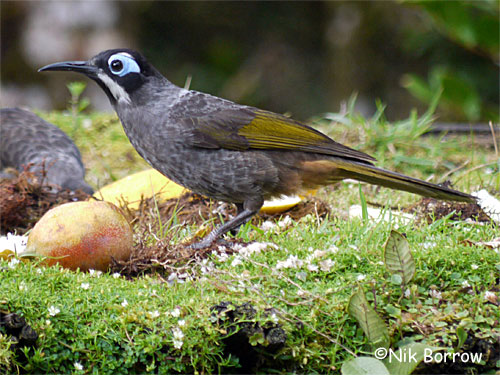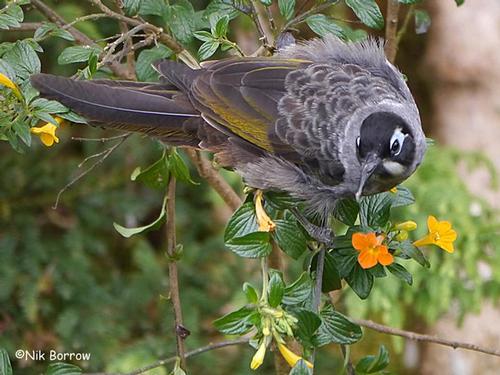
Melidectes belfordi
TAXONOMY
Melirrhophetes belfordi De Vis, 1890, Mount Knutsford, New
Guinea. Seven subspecies.
OTHER COMMON NAMES
English: Belford’s honeyeater; French: Mйliphage de Belford;
German: Belfordhonigfresser; Spanish: Pбjaro Miel de Belford.
PHYSICAL CHARACTERISTICS
10.7 in (27 cm); female 2.1 oz (60 g), male 2.6 oz (74 g). Light
blue bare face skin and whitish wattles. Crown, lores, cheeks,
and throat black, with white brow stripe and broad white
streaks at side of throat. Gray underparts with brownish belly
and undertail.
DISTRIBUTION
Central ranges of New Guinea from 5,250 to 12,500 ft (1,600
to 3,800 m). They also hybridize with yellow-browed
melidectes (M. rufocrissalis) in the eastern part of range.
HABITAT
Mountain rainforests, extending into pockets of shrubbery in
subalpine grasslands.
BEHAVIOR
Boisterous and aggressive toward other species at flowering
trees. Sail across openings with wings held widely spread, with
infrequent flaps. Noisy, loud, and repeated calls, with gurgling,
coughing, cackling, cawing, and piping notes.
FEEDING ECOLOGY AND DIET
Feed in canopy on nectar, arthropods, and some fruit. Glean
from vines and foliage and probe into moss and epiphytes.
REPRODUCTIVE BIOLOGY
Breeding season April to July or later. The deep cup-shaped
nest is made of moss, twigs, and hairs from the fronds of tree
ferns. Egg apparently undescribed.
CONSERVATION STATUS
Not threatened.
SIGNIFICANCE TO HUMANS
None known.
Other popular Animals
Photo Gallery of - Belford’s melidectes




 Animalia Life
Animalia Life